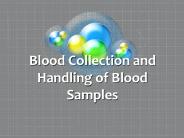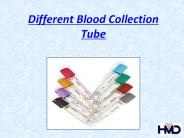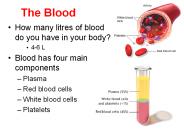Blood Clot PowerPoint PPT Presentations
All Time
Recommended
For a blood transfusion to be successful, AB0 and Rh blood groups must be compatible between the donor blood and the patient blood. If they are not, ...
| PowerPoint PPT presentation | free to view
Blood Groups, Blood Typing and Blood Transfusions The discovery of blood groups Experiments with blood transfusions, the transfer of blood or blood components into ...
| PowerPoint PPT presentation | free to view
The Blood The Blood Definition Blood is a connective tissue, not a body fluid, made of fluid (plasma) and cellular elements (RBC, WBC, and ...
| PowerPoint PPT presentation | free to view
Study of blood flow impact on growth of blood clot using a multiscale model
| PowerPoint PPT presentation | free to view
According to the latest research report by IMARC Group, The global blood clot retrieval devices market size reached US$ 1.4 Billion in 2023. Looking forward, IMARC Group expects the market to reach US$ 4.8 Billion by 2032, exhibiting a growth rate (CAGR) of 14.22% during 2024-2032. More Info:- https://www.imarcgroup.com/blood-clot-retrieval-devices-market
| PowerPoint PPT presentation | free to download
Blood Groups and Blood Typing How is blood type determined? Blood type is determined by the presence or absence of antigens on the surface of red blood cells as well ...
| PowerPoint PPT presentation | free to view
“The clot in the blood usually happens due to plaque buildup leading to clot formation,” professionals at Dr Ranjit Jagtap Clinic say. The clot may stop the blood flow to the heart, which can cause a heart attack. When a blood ball forms in the arteries of the heart that feeds the brain, it can cause a stroke.
| PowerPoint PPT presentation | free to download
“Thrombosis is harmful because it can be hazardous for life” Says Dr. Ranjit Jagtap, an energetic cardiovascular and thoracic surgeon, with Ram Mangal Heart Foundation Pune. “If not long, try walking around the office desk, wearing tight clothes causes blood clots so wear comfortable lines,” says Aditi Jagtap Pune.
| PowerPoint PPT presentation | free to download
Medical devices are expected to go through a series of tests before they are given the approval for the public use. However, the IVC filters, which are widely used for the treatment of preventing blood clots, have failed to keep up to its quality.
| PowerPoint PPT presentation | free to download
Medical devices are expected to go through a series of tests before they are given the approval for the public use. However, the IVC filters, which are widely used for the treatment of preventing blood clots, have failed to keep up to its quality. Retrievable inferior vena cava (IVC) filters, which were once declared an effective and safe alternative to the anticoagulants by the FDA has been now categorized as a high-risk medical device.
| PowerPoint PPT presentation | free to download
The global blood clot retrieval devices market continues to witness significant growth, driven by various factors such as the swelling elderly population, increasing healthcare spending of governments, and the growing demand for minimally invasive procedures.
| PowerPoint PPT presentation | free to download
“Blood clots in legs — how bad it can be?” Blood clots are not always life-threatening, but they can be and we do not want to put ourselves at risk. These blood clots can break off, pass through our blood circulatory system and get stuck in our lungs, which means we are dealing with a potentially fatal situation known as pulmonary embolism.
| PowerPoint PPT presentation | free to download
Circulatory System: Heart, Blood, Blood Vessels Transports Materials from the digestive and respiratory Systems to the cells. Blood fluid that carries material ...
| PowerPoint PPT presentation | free to download
Blood Collection and Handling of Blood Samples Reading your PCV Concentration of total protein / total solids Plasma protein concentrations estimated with a ...
| PowerPoint PPT presentation | free to download
Blood clotting is a sign of a healthy body. Sometimes blood clots get formed deep within the veins causing a condition known as Deep Vein Thrombosis. This type of clot is usually seen in the pelvis or leg of pregnant women. There is also a higher risk of these clots breaking away during pregnancy and travelling through the bloodstream to other parts of the body. Sometimes, clots can make their way up to the lungs (Pulmonary Embolism) and end up blocking the blood flow. To know more, visit https://www.cordlifeindia.com/blog/should-you-be-worried-about-blood-clots-during-pregnancy/
| PowerPoint PPT presentation | free to download
The IVC Filter might be potentially harmful for you causing heart and lung damages, breathing problems and blood clots.
| PowerPoint PPT presentation | free to download
The blood clot forming in the arms or legs is pretty serious as it can travel to your heart. You are more likely in getting DVT if you haven't moved for a long time, say after surgery. You are sure to seek help from a doctor if you see any of these symptoms.
| PowerPoint PPT presentation | free to download
Chapter 8 FORENSIC SEROLOGY Nature of Blood Blood is a highly complex mixture of cells, enzymes, proteins, and inorganic substances. Plasma, is the fluid portion of ...
| PowerPoint PPT presentation | free to view
Unit Six: Blood Cells, Immunity, and Blood Coagulation. Chapter 36: Hemostasis and Blood Coagulation. Guyton and Hall, Textbook of Medical Physiology, 12th edition
| PowerPoint PPT presentation | free to view
Unit Six: Blood Cells, Immunity, and Blood Coagulation. Chapter 33: Resistance of the Body to Infection. I. Leukocytes, Granulocytes, the Monocyte-Macrophage System ...
| PowerPoint PPT presentation | free to view
Blood cancer is a term for a cancer that influences the blood, bone marrow and lymphatic framework. There are numerous subtypes of blood cancer. Portrayed beneath are a portion of the more predominant types.Blood cancer alludes to any number of various sorts of cancer that influence the blood. Our blood is made of various kinds of blood cells, which are made in the bone marrow amidst our bones. There are three primary sorts of blood cells, including red blood cells (which convey oxygen), platelets (which assist blood with clotting), and white blood cells (which battle contaminations)
| PowerPoint PPT presentation | free to download
Blood consists of a pale yellow fluid called plasma in which are suspended white ... If blood is centrifuged the cells precipitate leaving the plasma as a supernatant. ...
| PowerPoint PPT presentation | free to download
Blood - The Evergreen State College ... Blood
| PowerPoint PPT presentation | free to download
Rh Blood Group - Kentucky Department of Education ... Blood!!
| PowerPoint PPT presentation | free to view
The average red blood cell transfusion is approximately 3 pints. ... Type O-negative blood (red cells) can be transfused to patients of all blood types.
| PowerPoint PPT presentation | free to view
BLOOD Elements Critical to RBC Production Folic Acid Vitamin B12 Iron Too few RBC = anemia Oxygen Levels Oxyhemoglobin = plenty of oxygen; bright red ...
| PowerPoint PPT presentation | free to download
Blood By the end of the lesson you should: Know the composition of Blood Know the function of red blood cells and plasma Know the different blood types
| PowerPoint PPT presentation | free to view
Title: BLOOD Author: BRYAN FAHRENBACH Last modified by: Teacher Created Date: 10/27/1996 1:43:10 AM Document presentation format: On-screen Show (4:3)
| PowerPoint PPT presentation | free to download
Blood & Blood Types Blood The River of Life Connective tissue - connects all the body systems. The average person has between 4-6 L of blood.
| PowerPoint PPT presentation | free to download
Blood Plasma Liquid portion of blood 55% of total blood volume 90% water Remainder contains dissolved proteins, glucose, clotting factors, mineral ions, and hormones ...
| PowerPoint PPT presentation | free to view
... pernicious anemia erythropoietin hormone synthesized by kidney decreased blood O2 stimulates secretion of erythropoietin by the kidney ...
| PowerPoint PPT presentation | free to view
Title: ch10blood Author: Barb Weekley Description: Chapter 10 Blood Last modified by: District 211 Created Date: 6/29/2001 10:21:34 PM Document presentation format
| PowerPoint PPT presentation | free to download
Blood Blood is the fluid through which gases, waste products, nutrients and hormones are transported throughout the body. The average human body contains 5L of blood.
| PowerPoint PPT presentation | free to view
Red Blood Cells. Biconcave disks that contain oxygen-carrying hemoglobin. Red ... The total number of red blood cells remains relatively constant due to a ...
| PowerPoint PPT presentation | free to download
BLOOD & FLUIDS Intermediate Lecture - Blood A&P * * * * * * * * * * * * * * * * * * * * * * * * * * * * * * * * * * * * * * * * * * * * * * * * * * * HEMOSTASIS ...
| PowerPoint PPT presentation | free to view
For many women, periods are a natural and regular part of life, but the different types of blood you experience during your menstrual cycle can provide valuable insights into your health. From the colour and consistency of your period blood to the presence of blood clots, each variation holds meaning about what’s going on inside your body. Let’s take a closer look at the different types of period blood, what they can reveal, and how to interpret the changes in your flow.
| PowerPoint PPT presentation | free to download
BLOOD CHAPTER 10 FUNCTIONS OF BLOOD BLOOD is in charge of homeostasis in 3 ways BY TRANSPORTATION- -deliver nutrients, oxygen and hormones to cells -carry away waste ...
| PowerPoint PPT presentation | free to download
Blood BINGO Write any 8 into your grid anaemia (blood) clotting haemoglobin rhesus factor blood deoxygenated lymphocyte(s) serum blood group(s) endothelium monocytes ...
| PowerPoint PPT presentation | free to download
form stacks to go through vessels. can bend and flex to get through narrow capillaries ... blood get thicker. strain on heart. RBC's. Regulation of Production ...
| PowerPoint PPT presentation | free to view
Oxygen (O2) and nutrients diffuse across capillary walls and enter tissues ... Color varies from scarlet to dark red. The pH of blood is 7.35 7.45. Temperature is 38 ...
| PowerPoint PPT presentation | free to view
DISTRIBUTES BODY HEAT EVENLY. MAKES UP 55% OF WHOLE BLOOD. CHAPTER 14. BUFFY COAT ... REMAINS ARE ELIMINATED BY PHAGOCYTES IN THE SPLEEN, LIVER AND OTHER BODY TISSUES ...
| PowerPoint PPT presentation | free to view
... Hemostasis Bleeding stops in a 3 step process Vascular spasms vasoconstriction temporarily decreases blood flow in damaged blood vessel limiting blood loss ...
| PowerPoint PPT presentation | free to view
Blood JEOPARDY!! Composition of Blood Plasma, Blood Typing Erythrocytes and Leukocytes Leukocytes, Platelets, and Blood Clotting Potpourri 10
| PowerPoint PPT presentation | free to download
Explore cutting-edge blood research that advances our understanding of hematology, disease prevention, and innovative treatments for blood-related conditions.
| PowerPoint PPT presentation | free to download
The Journal of Advances in Blood Research offers insights into the latest studies and advancements in blood health, promoting knowledge and innovation in the field.
| PowerPoint PPT presentation | free to download
With the Vaku-8 evacuated tube system, the blood is collected directly into the tube during the venipuncture procedure and is a closed system.
| PowerPoint PPT presentation | free to download
Blood Functions Blood maintains: Appropriate body temperature by absorbing and distributing heat to other parts of the body Normal pH in body tissues
| PowerPoint PPT presentation | free to view
The Blood How many litres of blood do you have in your body? 4-6 L Blood has four main components Plasma Red blood cells White blood cells Platelets
| PowerPoint PPT presentation | free to download
The blood volume in the body varies according to size of individual. ... The bilinubin form bile salts. ( Bile breaks down fats. ...
| PowerPoint PPT presentation | free to view
Title: Blood lab Author: ljackson Last modified by: ljackson Created Date: 4/18/2006 1:28:54 AM Document presentation format: On-screen Show Company
| PowerPoint PPT presentation | free to view
Whole blood consists of formed elements and plasma ... Important for blood clotting.Fit forms fibrin, which is the network for a blood clot ...
| PowerPoint PPT presentation | free to view
Origin - bone marrow ... Origin - bone marrow, lymph nodes,spleen ... Origin - bone marrow. Function - critical role in blood clotting. Platelets ...
| PowerPoint PPT presentation | free to view
The Fluid and Cells that are circulated through ... Blood is the means by which 1) oxygen and nutrients are transported to the ... Death results from asphyxia. ...
| PowerPoint PPT presentation | free to view
























































